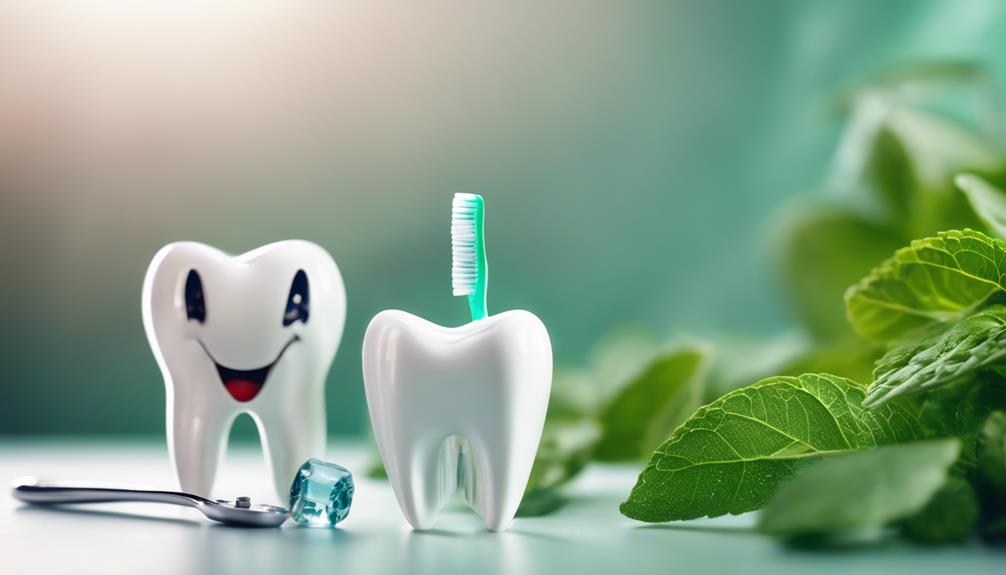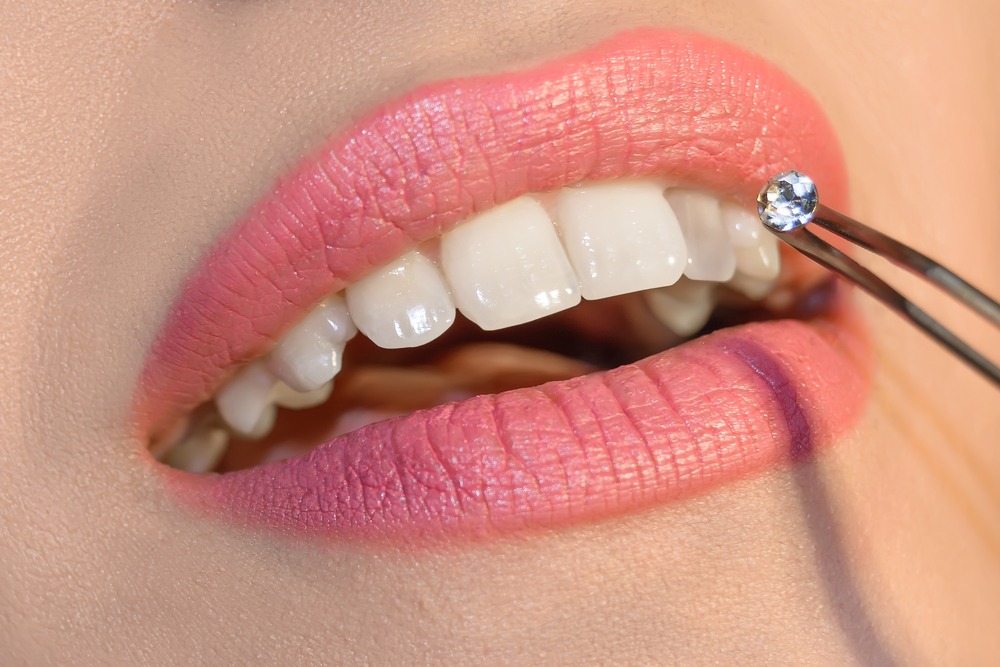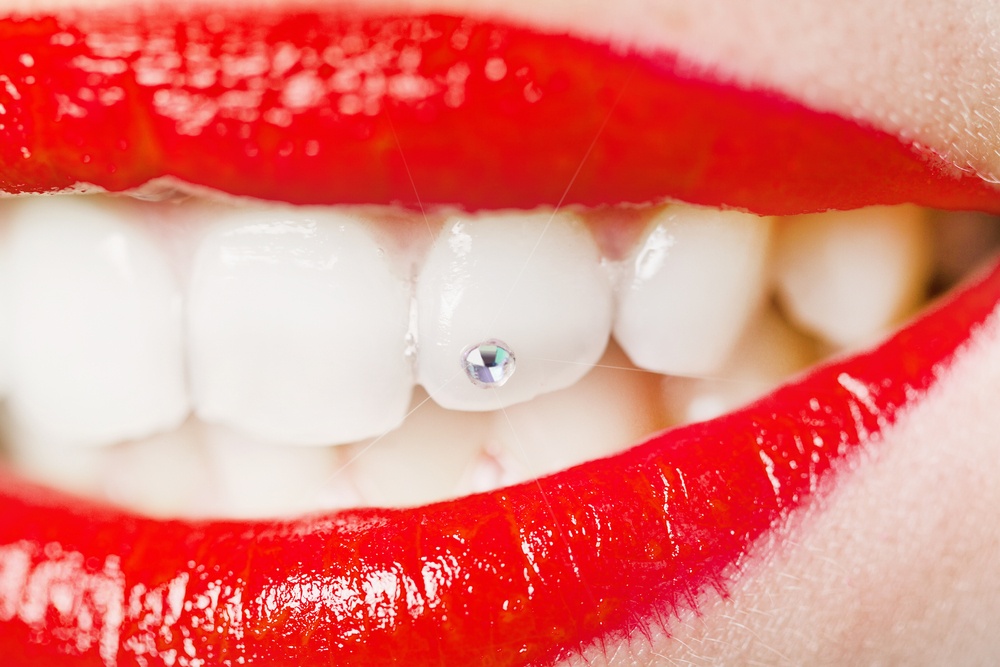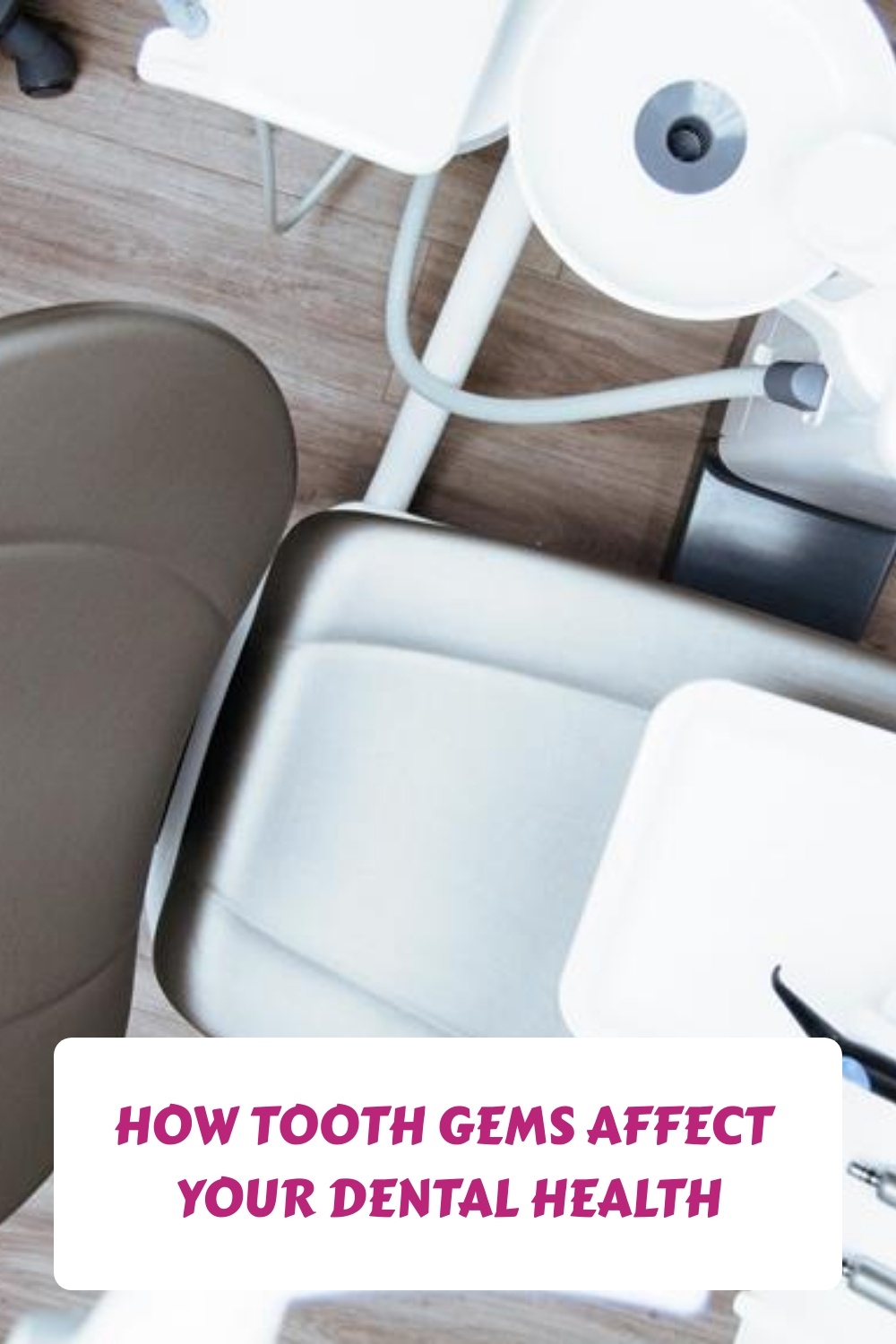Are you considering brightening your smile with tooth gems? They might look cool, but you have also got to weigh the dental health impact on your teeth. Sticking those sparklers on can slightly damage your enamel – that’s the outer layer of your teeth. Getting it wrong could mean saying hello to plaque buildup, risking gum issues, and even “inviting tartar to the party”. Over time, that glamorous addition might weaken, creating havens for decay or causing pressure that messes with your tooth’s integrity. And if you ever change your mind? Safe removal is a job that in my opinion, should be left to the pros to keep that enamel safe. Depending on the bling material, you might also face allergy risks. Hang out with me for a little while to share the best ways to keep that smile bright, with or without the extra sparkle.
Key Takeaways
- Tooth gems can increase the risk of plaque buildup, affecting gum health and potentially leading to tartar formation.
- The adhesion process for attaching gems may damage tooth enamel if not done carefully, risking the tooth’s integrity.
- Over time, the bond between the tooth and the gem itself may weaken, posing a risk of chipping teeth and creating rough spots prone to decay.
- Professional removal by a dentist is the safest option to ensure the tooth enamel remains intact and to safely remove adhesive residues.
- Allergic reactions to materials used in tooth gems vary, with metals posing a high risk and glass gems a low risk.
Adhesion Process Risks
The adhesion process for attaching tooth gems involves etching your tooth’s surface, which can lead to enamel damage and should not be taken lightly. You are allowing a tiny part of your tooth’s armor to be removed for the sake of sparkle. Imagine exchanging a shield for a bit of glitter – it can be risky business if you are not careful!
Before you consider investing in a tooth gems kit or racing to Google searching for ‘tooth gems near me,’ remember that your dental health must not be compromised. This is because the process is not as straightforward as sticking on a gem and calling it a day. The adhesive used needs to be strong enough to keep the gem(s) in place, but not so harsh that it jeopardizes your tooth’s integrity. It’s a delicate balance, one that requires expertise to get right in one go.
Plaque and Gum Health
When you select tooth jewels, it’s important to consider how they may complicate plaque removal and if they could negatively impact your gum health. The nooks and crannies around these sparkling additions become vantage points for plaque, a sticky, bacteria-laden film. If you are not careful, this plaque hardens into tartar, a tougher customer that only your dentist’s or hygienist’s tools can remove.
Lest we forget, your gums hold your teeth firmly in place. When plaque builds up, it can irritate and inflame your gums. Picture a tiny battle, where your gums are fighting off nasty bugs from a shiny, but potentially problematic, decoration. This inflammation, known as gingivitis, can escalate into periodontitis, a more serious gum disease that can lead to tooth loss.
Long-Term Wear Concerns
While addressing plaque and gum health is important, it’s also essential to think about how the long-term wear of tooth gems might impact your teeth. Over time, you might notice the bond between your tooth and the gem weakening. If the gem decides to part ways with your tooth and isn’t replaced or professionally removed, you are left with a rough spot that’s like a welcome mat for tooth decay. Plus, there’s always that lingering risk of chipping your tooth. Imagine biting into an apple and—oops!—there goes a piece of your tooth along with the gem….Not a pretty picture as I am sure you can picture in your mind.
The truth is, your teeth were not designed to be “bling holders”. The constant contact and pressure can spell trouble, not just for the surface of your tooth but for its overall integrity. You’ve got to weigh the sparkle against the potential for creating hideouts for bacteria or even weakening your tooth’s natural defenses. It’s like hosting a party on your teeth that went a bit too wild, and now you’re left dealing with the aftermath. So, before turning your smile into a jewelry display, consider how your dental health might be affected in the long run.
Removal Procedures
Opting for professional removal virtually guarantees that your tooth gem‘s removal does not compromise your dental health. When you have decided to part ways with your sparkly “Companion for teeth” or “Dental companion”, it’s essential to choose a dentist’s expertise rather than taking matters into your own hands. You see, DIY removal methods are risky ill, and potentially damaging. Your dentist will use specialized tools and techniques to make sure the gem is removed safely, leaving your tooth enamel intact and unharmed.
The process involves gently lifting the gem from the tooth surface, a task that requires precision and understanding of dental materials. After the gem is removed, your dentist will also take care of any adhesive residue, ensuring that your tooth is as good as new. They might polish the tooth to restore its natural smoothness, eliminating any potential hideouts for plaque and bacteria.
Material Allergy Risks
Another point to note…Have you thought about the possibility that the materials used for tooth gems might trigger an allergic reaction? While the sparkle of a tooth gem can be irresistible, think about the potential for material allergies, which could turn your dazzling smile into a “dental dilemma”.
| Material Type | Allergy Risk |
|---|---|
| Metals | High |
| Glass | Low |
| Crystals | Moderate |
| Synthetic | Variable |
Metals, often used for their durability and shine, can be the most common culprits behind allergic reactions. Nickel and chromium, in particular, can lead to uncomfortable symptoms such as itching, redness, and even swelling around the gem site. Glass gems pose a lower risk, being generally inert, but are not entirely risk-free. Crystals, while less likely than metals to cause an allergic reaction, still pose a moderate risk, especially if you’re sensitive to specific types. Synthetic materials offer a mixed bag—some are designed to be hypoallergenic, while others can unexpectedly cause reactions.
Knowing your sensitivities and choosing your gem material wisely can help you avoid any unwanted itch or irritation. It’s not just about adding sparkle; it’s about doing it safely.
Pre-Application Considerations
Before you decide to add a tooth gem, it’s crucial to evaluate your dental health thoroughly. Diving into this trend without examining the potential risks can lead to complications down the line. Here’s a roadmap to guarantee you’re making an informed decision:
- Check Your Dental Health: Start with a clean bill of health. If you’ve got cavities or gum disease, address these first. Tooth gems shouldn’t complicate existing issues.
- Consult a Dental Professional: A quick chat with your dentist can provide personalized advice. They’ll know if your teeth are in the right shape for a gem and can warn you about potential risks.
- Understand the Process: Familiarize yourself with how tooth gems are applied. Knowing about the etching and adhesive process will help you grasp what your tooth is going through.
- Consider the Long-Term Impacts: Always think about how you may feel about your tooth gem in a few years from today! Trends change, and so might your fashione tastes.
Oral Hygiene Maintenance

After considering the impacts and your dental health, maintaining peak oral hygiene becomes even more vital when you have a tooth gem.
Brushing twice a day becomes essential; it is your daily forte against the buildup of plaque. But with a tooth gem, you need to finesse your brushing technique, ensuring you are gentle around the gem to prevent dislodging while still being thorough. Flossing is not a suggestion; it is a must-do to keep the areas around your gem free from food particles that could invite destructive bacteria.
Do not forget, rinsing with an antimicrobial mouthwash adds an extra layer of defense, like a protective shield for your enamel and gums. And here is a pro tip: regular check-ups with your dentist are not just for catching up on the latest gossip. They are essential for ensuring your tooth gem isn’t throwing a wrench in your oral health game plan. So, gear up and keep that smile not just beautiful, but strong and healthy too.
Frequently Asked Questions
Can Tooth Gems Be Applied to Dental Restorations Like Crowns or Veneers, and What Are the Implications if So?
You are curious if tooth gems can jazz up your dental restorations like crowns or veneers. Technically, yes, but there is a catch. These surfaces are not the same as your natural enamel, meaning the adhesion might not be as strong or lasting. Plus, if the gem falls off or damages the restoration, you are looking at a costly fix. Always chat with your dentist first to avoid turning your “sparkle into a hassle”. No pun intended :).
How Do Tooth Gems Affect the Accuracy of Dental X-rays or MRI Scans, if at All?
You might wonder if tooth gems mess with dental X-rays or MRI scans. Generally, they do not greatly affect X-rays, but they could cause small shadows or artifacts, making it a tad harder to spot issues right under the gem. As for MRI scans, no sweat—they’re mostly unaffected. But, it’s always smart to tell your dentist or tech about your bling to avoid any possible hiccups in your diagnosis.
Are There Specific Types of Tooth Gems That Are Considered Safer or More Biocompatible With Dental Tissues?
Imagine your smile sparkling like a star-studded sky, thanks to tooth gems. But wait, are some gems friendlier to your teeth than others? Absolutely! Biocompatible gems, which mesh well with dental tissues, are the way to go. They are less likely to cause reactions or damage. It is like choosing the best climbing gear for a smooth ascent – you want materials that work with, not against, your body. Consider consulting a professional to pick wisely!
Can Tooth Gems Be Used to Cover Up or Camouflage Minor Dental Imperfections, Such as Small Chips or Discolorations?
You might think tooth gems can hide small chips or discolorations, but it’s not that simple. While they add sparkle, they don’t fix dental issues. Attaching a gem might remove a bit of enamel and make cleaning harder, leading to plaque buildup. It’s better to address imperfections directly with your dentist. Remember, gems are for style, not solutions, so consider your dental health first before going for that glitter.
How Does the Presence of a Tooth Gem Impact the Effectiveness of Teeth Whitening Procedures or Products?
Imagine you’re sprucing up your phone with a shiny sticker, but then you try to put a screen protector over it. Doesn’t work smoothly, right? That’s like adding a tooth gem and expecting your teeth whitening to be even. The gem creates a spot that whitening agents can’t reach, leading to uneven color. It’s important to think about this before opting for that sparkler, ensuring your smile shines uniformly, gem or no gem.
Conclusion
To sum it up, embellishing your teeth with gems is like adding frosting to a cake—it enhances things more captivating, but it’s not without its sticky parts. You’ve got to balance the twinkle against the potential for enamel damage, plaque buildup, and gum issues. Before diving in, consider the risks, contemplate the maintenance, and consult a professional. Remember, keeping your smile bright is a marathon, not a sprint, so take care of those gorgeous teeth of yours!





This is a very helpful and insightful explanation of the way in which tooth gems can affect your dental health. So tooth gems might add a sparkle to your smile, but when I see all the negative aspects of tooth gems, it is not something that I will encourage anyone to add to their teeth.
From possible damage to the enamel of your teeth, to plaque build-up, there are far more negative issues, than positive ones. Apart from adding bling, what are the other reasons for someone to have tooth gems? Is it more prevalent in certain cultures, than others? Thank you.
Hi LineCowley
Thank you for your thoughtful comment and kind words about my article on tooth gems and dental health. I appreciate you taking the time to share your insights and questions.
You have raised an excellent point about the potential risks associated with tooth gems outweighing the aesthetic benefits. While tooth gems can add that aesthetic appeal, you do need to consider the long-term implications for dental health.
As you mentioned, tooth gems can lead to enamel damage and plaque accumulation, which may result in tooth decay and other oral health issues. Regarding your question about other reasons people might choose to have tooth gems, apart from the “bling” factor, there are a few possible motivations.
Some individuals may view tooth gems as a form of self-expression or a way to showcase their personality.
Others might see them as a fashion statement or a means to stand out from the crowd. In certain cases, tooth gems may hold cultural or religious significance, such as in some Southeast Asian cultures where they are believed to protect against evil spirits!
The prevalence of tooth gems does vary across different cultures and demographics. In some parts of the world, such as Southeast Asia and Latin America, tooth gems have a longer history and are more widely accepted.
However, in Western countries, they are often considered a more contemporary and alternative fashion choice, particularly popular among younger generations and certain subcultures, such as the hip-hop and rap communities.
It is important to note that while cultural factors may influence the decision to get tooth gems, it is always advisable to prioritize one’s dental health and consult with a qualified dentist before making any modifications to your teeth.
Thank you once again for your insightful comments and thought-provoking questions. We hope this response has provided some additional context and addressed your concerns.
If you have any further questions or topics on this subject you would like me to cover, please do not hesitate to let us know.
I value your engagement and look forward to continuing the conversation about dental health and well-being.
Best regards,